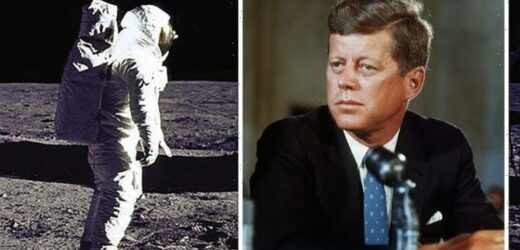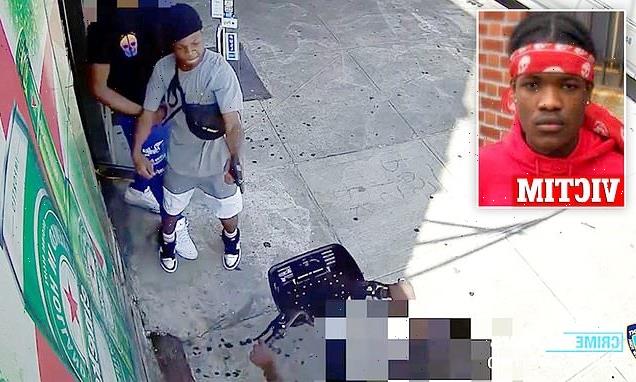Apollo 11: Brian Cox says ‘aerospace wasn’t ready for it’
We use your sign-up to provide content in ways you’ve consented to and to improve our understanding of you. This may include adverts from us and 3rd parties based on our understanding. You can unsubscribe at any time. More info
Neil Armstrong, Buzz Aldrin and Michael Collins were blasted off from the Kennedy Space Centre for their Apollo 11 mission to the Moon 52 years ago today. Their success fulfilled President John F Kennedy’s goal of landing man on the lunar surface by the end of the Sixties and brought an end to a bitter Space Race with the Soviet Union. Uncovered recordings from a meeting at the Oval Office in 1963 previously showed that Kennedy had doubts about the Apollo Project after investing more than $25billion (£18billion) on the “most ambitious space programme in national history”.
But author and curator of the Smithsonian’s Apollo collection, Teasel Muir-Harmony, uncovered documents from the US Information Agency (USIA) that appear to explain why he pursued it.
She claims that Kennedy “didn’t propose it for the sake of science,” and it was instead a “demonstration of what the American industry was capable of and a demonstration of American values”.
Dr Muir-Harmony dug through troves of government documents to produce her book ‘Operation Moonglow: A Political History of Project Apollo’ in an attempt to “shine a light on the little-known role” that propaganda and foreign relations played.
The idea of landing man on the lunar surface was first conceived by the Eisenhower administration as a way to “contain Communism, align the world with the US and shore up America’s power”.


But when Kennedy took office in 1961, he apparently saw an opportunity.
USIA Acting Director Donald Wilson told Dr Muir-Harmony that Kennedy was “a man who perhaps better than any other president in our history, understood how foreign opinion worked, what moulded it, what shaped it and how to shape it”.
That apparently meant doing things differently to the USSR.
Dr Muir-Harmony explained: “The Soviet Union was relatively closed about what they were launching, when they were launching it and their technology.
“The US took a different tack, inviting the press to cover launches and sending spacecraft around the world.”

In 1961, Freedom 7 – the capsule that carried the first American into space – was exhibited in Paris and Rome, drawing more than a million visitors.
A USIA report to Congress that features in Dr Muir-Harmony’s book reads: “Two young men soared into space early this year.
“The Russian was the first one up, but the American’s achievement was more widely heard and even more widely believed.”
They also showed that after John Glenn became the first man to orbit the Earth in 1962, the USIA and the State Department selected cities that would be “most strategically advantageous” to exhibit his capsule – Friendship 7.
On its first showing in London, thousands were turned away due to overcrowding and in Paris visitors waited five hours, forcing the museum to stay open until midnight.
Documents show that American embassies around the world were desperate for a visit of their own.
This is said to have come with benefits to Washington.
DON’T MISS
Black hole shock: Scientist’s dire warning to humans [VIDEO]
Asteroid apocalypse: Scientist warns of ‘city-destroying’ space rock [OPINION]
Why ‘Trillion tonne rock hurtling towards Earth’ was ‘bad news’ [EXPLAINED]


The US embassy in Turkey wrote that a visit would be “extremely useful [for] this NATO partner which directly confronts the USSR”.
On July 20, Armstrong and Aldrin brought an end to the Space Race by burying the US flag into the dusty surface of the Moon.
Kennedy never got to see it, as he was assassinated in November 1963, but it appears the propaganda machine did not stop churning.
Dr Muir-Harmony writes that President Richard Nixon timed a “diplomatic tour explicitly to take advantage of the international popularity of the Moon landing”.
Operation Moonglow sought to demonstrate a concern for Asia and Eastern Europe and a commitment to securing peace in Vietnam with the message that “if mankind can send men to the Moon, then we can bring peace to the Earth”.
But Dr Muir-Harmony claims that, using the trip for cover, Nixon and his national security advisor, Henry Kissinger, were able to have secret meetings with the North Vietnamese that helped pave the way to ending the war.
As Kennedy had envisioned, the space programme went a long way toward improving America’s brand, and what the author concludes as creating “a sense of goodwill”.
‘Operation Moonglow: A Political History of Project Apollo’ is published by Basic Books and available to purchase here.
Source: Read Full Article

